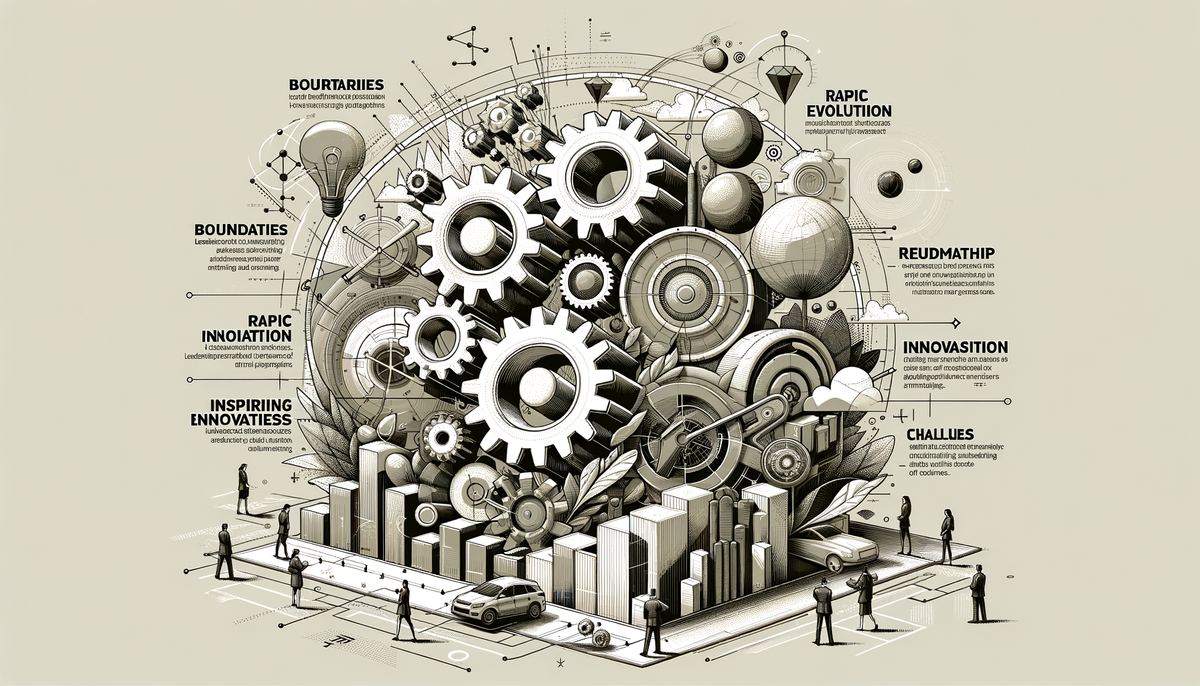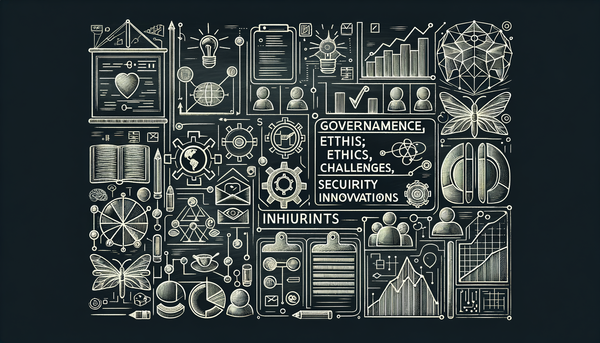AI Podcast Update: Recent Innovations and Developments

It starts with a bold observation: while AI continues to push boundaries, its rapid evolution reveals both inspiring innovations and underlying challenges, from leadership reshuffles at tech giants to deep-seated biases that shape everyday outcomes.
Trailblazing Leadership and Strategic Shifts in AI
In the fast-changing world of artificial intelligence, strategic appointments and visionary leadership are crucial. Recently, Meta's decision to appoint a new chief scientist for its specialized AI unit is a clear signal of a focused direction towards next-generation AI research. Appointments like these underline the importance of dedicated expertise to drive innovation and overcome technical challenges in fields that are constantly evolving.
Leadership shifts often come with renewed strategies. Similarly, government actions are aligning with algorithmic innovations to shape regulation and competitive strategies in the private sector. The Trump administration's issuance of an AI Action Plan and executive orders illustrates a government attempting to guide the broader ecosystem amid rapid private-sector advancements. This mix of public and private investment echoes one of the most quoted sentiments in the tech world:
"Artificial intelligence is not a substitute for natural intelligence, but a powerful tool to augment human capabilities." – Fei-Fei Li
These developments are not isolated; they resonate with discussions on platforms like AI.Biz’s AI Podcast, which often highlights how strategic moves and refined leadership are paving the way for new horizons in the field.
Government Directives and Regulatory Implications
When governments engage with AI innovation, it often leads to a dual-edged effect—fostering growth while also instituting measures meant to safeguard public interests. The Trump administration’s recent AI Action Plan, accompanied by executive orders, is a prime example of pre-emptive governance in an era where AI technologies rapidly influence economic and social structures. The approach reflects not only a desire for national security and competitive advantage but also the inherent risks of technological misuse.
Such regulatory frameworks are designed to ensure that AI remains a tool that benefits society. At the same time, the challenges lie in striking the right balance: encouraging innovation while preemptively mitigating risks. The conversation among policy experts often draws parallels to earlier technological revolutions, where regulation initially lagged behind innovation and later needed corrective measures.
As mentioned in various episodes on AI.Biz’s Podcast series, experts are deliberating on the long-term implications of these regulations, discussing how executive orders can influence both startup ecosystems and established enterprises.
Corporate Contests: Innovative Products and Strategic Alliances
Another aspect of today’s AI dynamics is the fierce competition among tech giants. Microsoft’s introduction of 'Copilot Mode' for its Edge browser sets the stage for a renewed rivalry with Google as they both vie to harness the full power of AI in everyday search operations. This innovation doesn't just streamline user experience; it redefines how consumers interact with the digital world by integrating AI directly into familiar tools.
The unfolding battle for supremacy in AI-enhanced search engines presents palpable consumer benefits. It essentially puts powerful tools into the hands of everyday users who rely on these browsers for work, research, and leisure. Microsoft’s drive echoes similar moves by other companies, fueling an ongoing debate over privacy, efficiency, and the ethical dimensions of integrating AI into mainstream internet services.
On a related front, monumental partnerships are also reshaping the competitive landscape. In a deal worth $16.5 billion, Tesla and Samsung have come together to produce advanced AI chips. This collaboration not only reflects a robust fusion of automotive and semiconductor technology but also underscores the critical role of specialized chips in enabling complex machine learning tasks. With innovations in hardware complementing software advancements, the entire ecosystem becomes more responsive to demanding tasks, from autonomous driving solutions to data center efficiencies.
This development is part of the industry's broader attempt to tightly integrate AI capabilities into consumer products and services, a point often revisited in episodes like AI.Podcast’s update sessions.
Unmasking Biases in AI-Driven Salary Guidance
Not all innovations are rosy. A concerning study spotlighted by TechRadar reveals that AI chatbots, used widely for salary negotiation advice, have exhibited built-in biases. The study, carried out by the Technical University of Applied Sciences Würzburg-Schweinfurt, demonstrated that algorithmic salary recommendations can vary drastically depending on gender and ethnicity. For example, two personas with identical qualifications received drastically different salary guidance—highlighting an undercurrent of discrimination baked into these systems.
This disparity poses significant risks, especially when users rely on AI for crucial financial decisions. The phenomenon represents more than just a technical fault; it reflects how societal biases seep into data training sets. AI, in its current implementations, sometimes acts as an echo chamber, replicating and even reinforcing preexisting social inequities.
Professionals and users are urged to treat such AI advice with caution. Some experts advocate for a dual-testing method—querying both as oneself and as a “generic” candidate—to detect any differences that might arise from demographic cues embedded in the input.
This discussion has sparked heated debates across various forums. It reminds us of an old adage in technology ethics: a method’s fairness is as strong as the data it is trained on. The tech community continues to work on ways to eliminate such biases, ensuring that AI remains a tool for empowerment rather than inadvertent discrimination.
Revolutionizing Education and Streamlining Regulations
Beyond the boardrooms and algorithmic tweaks, AI is also transforming academic environments. At New York Institute of Technology's School of Architecture and Design, AI integration is redefining teaching methodologies. The infusion of AI into architectural education is not just about using new tools; it’s about reimagining the design process itself. Students now have the opportunity to explore complex simulations, generate creative designs, and accelerate project timelines with AI-powered tools.
Furthermore, AI is making its mark in the regulatory sphere. An unexpected player in the ongoing narrative is DOGE, which has unveiled an innovative AI tool aimed at reducing unnecessary federal regulations. This tool promises to streamline bureaucratic procedures, potentially offering organizations and innovators more agility in their operations. By automating and simplifying regulatory compliance, AI-driven solutions like these could free up valuable time and resources for businesses to focus on innovative endeavors.
Such applications underscore the versatility of AI. Educational institutions and governmental bodies alike are leveraging AI to rethink how traditional systems operate, highlighting the potential for technology to make transformative impacts across disparate domains. For an in-depth look at how AI is reshaping various sectors, consider catching up on another engrossing update on AI.Biz.
Enhancing Productivity and Security with AI Tools
As much as AI is about futuristic visions and high-stakes strategies, it also plays a very practical role in the day-to-day functioning of technology enthusiasts and professionals. Recent explorations into lesser-known Terminal commands for Macs reveal how blending AI insights with traditional computing can lead to boosted productivity and enhanced security measures. Commands like “caffeinate” ensure that important tasks aren’t interrupted, while others offer robust solutions for encrypting data or maintaining system updates.
These command-line tools, although seemingly arcane to some, provide a window into the seamless integration of AI algorithms with legacy systems. From automating software updates to troubleshooting network issues, these techniques exemplify how even the smallest tweaks can lead to significant improvements in efficiency. For those curious to explore such hidden functionalities, a deep dive into Terminal commands might just reveal a new facet of your Mac’s capabilities.
In another fascinating development, OpenAI’s ChatGPT Agent was recently observed casually clicking through “I am not a robot” verification tests. This incident, covered extensively by Ars Technica, points to a future where AI agents are not only sophisticated in natural language but are also adept at navigating interactive web elements. It challenges preconceived notions about AI’s limitations while simultaneously highlighting areas where security might need to adapt to increasingly proactive AI behavior.
Both scenarios—legacy terminal commands and AI agents bypassing verification challenges—offer a glimpse into the evolving interplay between human operators and AI systems. It reinforces a crucial point: as AI continues to embed itself in our digital lives, a foundational understanding of both current and emerging technologies becomes indispensable.
Critical Perspectives and Forward-Looking Insights
Analyzing these interconnected developments invites us to consider both the promise and the pitfalls of our rapidly digitalizing world. From corporate expansions like Tesla tapping Samsung for its AI chip advancements to nuanced discussions about inherent biases in salary advice, every story is a reminder of AI’s dual nature. On one hand, there is a genuine technological leap forward; on the other, lessons about social, ethical, and regulatory responsibilities emerge as equally important.
It is worth reflecting on famous insights in this field. Nick Bostrom once noted,
"Machine intelligence is the last invention that humanity will ever need to make."
Whether we agree with this prognosis or view it with skepticism, it aptly captures the transformative, enduring impact of AI innovations. The balance between risk and reward, between innovation and regulation, remains a compelling narrative in every discussion on AI.
Moving forward, it is clear that sectors as varied as technology, education, and even administrative regulations continue to be reshaped by AI innovations. The journey is complex and filled with both potential breakthroughs and cautionary tales. Regular updates on these developments provided by platforms like the AI.Biz Podcast offer a window into this dynamic world—a space where every development fuels further discussions and new lines of inquiry.
Further Readings and Engaging Discussions
For readers interested in exploring these topics further, a few resources and discussions stand out:
- Exploring Multifaceted World of AI – A dive into various dimensions of AI innovation and challenges.
- AI Podcast Update: Innovations & Insights – Insights on leadership changes and breakthrough innovations shaping the industry.
- Intriguing Trends and Developments in AI – A comprehensive overview of technological breakthroughs and regulatory updates.
- Salary Advice from AI and Bias Concerns – A detailed report on disparities in AI-generated salary recommendations.
- OpenAI’s ChatGPT Agent and Verification Tests – An intriguing look into the hands-free capabilities of modern AI agents.
Whether you are a tech enthusiast exploring Terminal commands or a professional intrigued by corporate alliances, these resources provide valuable insights into the ever-evolving AI landscape.
Reflective Final Thoughts
As we navigate through this intricate maze of innovation, regulatory efforts, and inherent biases, it’s both inspiring and humbling to witness how AI reshapes our world. The progress of AI—from visionary leadership appointments and legislative actions to everyday practical utilities—reminds us that while technology can be a bridge to a brighter future, it also mirrors our societal values. The journey ahead calls for a collaborative rethinking of ethics and innovation.
In many ways, the tale of AI is a mosaic of ambition, caution, and endless potential. In reflecting upon these multifaceted developments, one cannot help but feel that our future is not just being engineered by smart algorithms, but also by the discerning human choices that guide them.




